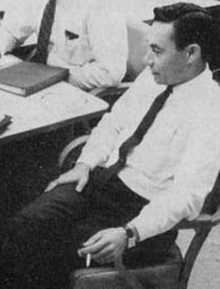This article may misquote or misrepresent many of its sources. Please see the cleanup page for more information. (June 2022) |
Mohamed Martin Atalla | |
|---|---|
| محمد عطاالله | |
 Mohamed Atalla as Director of Semiconductor Research at HP Associates in 1963 | |
| Born | August 4, 1924 |
| Died | December 30, 2009 (aged 85) |
| Nationality | Egyptian American |
| Other names | M. M. Atalla "Martin" M. Atalla "John" M. Atalla |
| Education | Cairo University (BSc) Purdue University (MSc, PhD) |
| Known for | MOSFET (MOS transistor) Surface passivation Thermal oxidation PMOS and NMOS MOS integrated circuit Hardware security module |
| Children | Bill Atalla[1] |
| Engineering career | |
| Discipline | Mechanical engineering Electrical engineering Electronic engineering Security engineering |
| Institutions | Bell Labs Hewlett-Packard Fairchild Semiconductor Atalla Corporation |
| Awards | National Inventors Hall of Fame Stuart Ballantine Medal Distinguished Alumnus IEEE Milestones IT Honor Roll |
Mohamed M. Atalla (Arabic: محمد عطاالله; August 4, 1924 – December 30, 2009) was an Egyptian-American engineer, physicist, cryptographer, inventor and entrepreneur. He was a semiconductor pioneer who made important contributions to modern electronics. He is best known for inventing, along with his colleague Dawon Kahng, the MOSFET (metal–oxide–semiconductor field-effect transistor, or MOS transistor) in 1959, which along with Atalla's earlier surface passivation processes, had a significant impact on the development of the electronics industry. He is also known as the founder of the data security company Atalla Corporation (now Utimaco Atalla), founded in 1972. He received the Stuart Ballantine Medal (now the Benjamin Franklin Medal in physics) and was inducted into the National Inventors Hall of Fame for his important contributions to semiconductor technology as well as data security.
Born in Port Said, Egypt, he was educated at Cairo University in Egypt and then Purdue University in the United States, before joining Bell Labs in 1949 and later adopting the more anglicized "John" or "Martin" M. Atalla as professional names. He made several important contributions to semiconductor technology at Bell Labs, including his development of the surface passivation process and his demonstration of the MOSFET with Kahng in 1959.
His work on MOSFET was initially overlooked at Bell, which led to his resignation from Bell and joining Hewlett-Packard (HP), founding its Semiconductor Lab in 1962 and then HP Labs in 1966, before leaving to join Fairchild Semiconductor, founding its Microwave & Optoelectronics division in 1969. His work at HP and Fairchild included research on Schottky diode, gallium arsenide (GaAs), gallium arsenide phosphide (GaAsP), indium arsenide (InAs) and light-emitting diode (LED) technologies. He later left the semiconductor industry, and became an entrepreneur in cryptography and data security. In 1972, he founded Atalla Corporation, and filed a patent for a remote Personal Identification Number (PIN) security system. In 1973, he released the first hardware security module, the "Atalla Box", which encrypted PIN and ATM messages, and went on to secure the majority of the world's ATM transactions. He later founded the Internet security company TriStrata Security in the 1990s. He died in Atherton, California, on December 30, 2009.
- ^ Bassett, Jackie (2006). So You Built It And They Didn't Come. Now What?. Sales of Innovative Products. p. 109. ISBN 978-1-4259-1546-9.